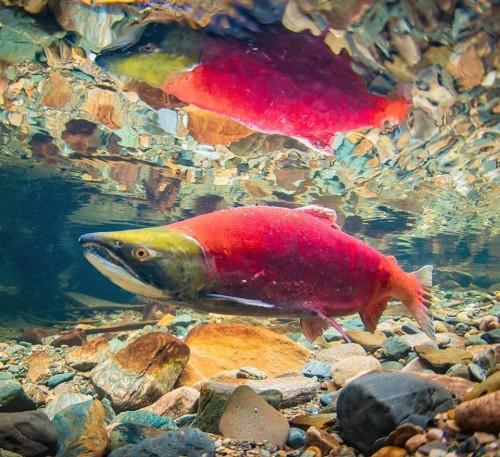SPECIES ID / Freshwater Fish of the Fraser Valley
Salmon/Trout/Char (Salmoninae)
Sockeye Salmon/Kokanee
sthéqi
Oncorhynchus nerka
Identification Tips:
• Adults at sea are silvery with faint blue-green speckling on back
• No dark spots on back, flanks, or fins
• 3 to 6 kg typically
• Male spawners have bright red bodies, green heads and sharply hooked jaws
• Female spawners are similar but with less pronounced colouration and jaws
• Anal fin base is longer than dorsal fin base
• No dark strip on dorsal fin of fry
• Juveniles have small oval, dark parr marks on sides
• Kokanee are much smaller than Sockeye
• Rare black Kokanee occur in a few lakes and streams
Conservation Status:
| British Columbia | Canada | Natureserve | |
| COSEWIC | Species at Risk Act | ||
| Not at Risk (Yellow List) | Endangered | None | G5, S4 |
Information Source: BC Conservation Data Centre: http://a100.gov.bc.ca/pub/eswp/
Life History:
• Two primary life history types: Sea run Sockeye, and lake dwelling Kokanee
• Both forms are often found in the same watershed
• Typically spawn in fall, August to November, depending on stock
• Sockeye typically rear 1 to 2 years on freshwater before going to sea
• Most spend1 to 3 years at sea, to complete a 4 year life cycle; but other variations occur
• Jack males spawn after just one year at sea, at much smaller size
• Fry and juveniles feed on zooplankton or small invertebrates
• Juvenile smolts migrate, by night, to estuary habitats in early spring and move into the sea in May
• Adults at sea eat larger invertebrates, squid and small fish
Habitat:
• Prefer to spawn where groundwater upwells, usually in river gravels but sometimes on beaches/shoals of lakes
• Juveniles of almost all populations rear for one to two years in large lakes
• Rare river rearing stocks occur, including in the Pitt and Harrison Rivers.
• Fry may pend first month in shallow near shore habitat
• Adult and juvenile Kokanee live offshore in lakes and often migrate from deep water to shallow water at dawn and dusk to feed
Range:
British Columbia
• Found in over 300 lakes and river systems
• Present in most westward flowing rivers
• May ascend Fraser and other large rivers thousands of km to headwaters
• Kokanee present in many lakes
Global
• Sacramento River (California) to McKenzie River in Beaufort Sea
• Northern Japan and Siberia
Comments:
• Among the most highly prized food fish in British Columbia
• Central to culture of most Indigenous communities in BC
• Over 900 Sockeye and 500 Kokanee populations in BC
• Of these 20 are extinct
• Fraser River Sockeye are divided into 24 management units
• Of these over half are listed as species at risk: 8 endangered, 2 threatened and 5 special concern
––––––
Primary Information Source:
McPhail, J.D. 2007. The Freshwater Fishes of British Columbia. University of Alberta Press. Edmonton, Alberta.


